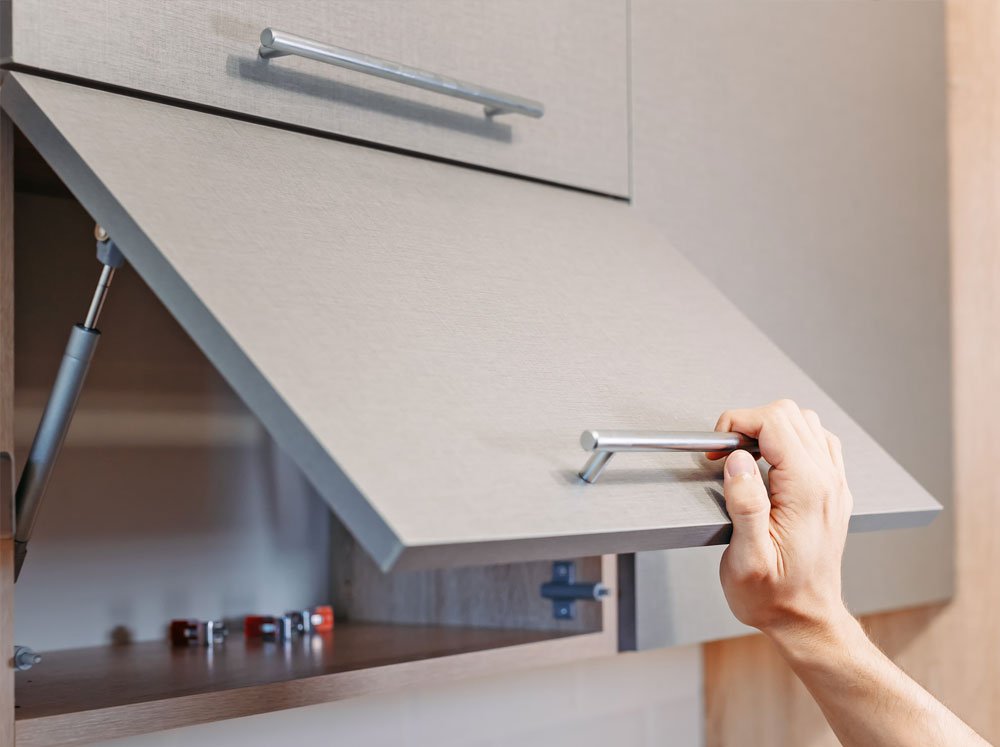Ottawa Cabinets
Cabinet Finishing
We go to great lengths to eliminate the stress of finding the perfect finish. We offer a full range of finishes and wood species to produce the design of your dreams for your home, office or cottage.


Contemporary, Rustic, Victorian, Colonial, Shaker, Euro-style and Mission. We’ve covered it all. We also stay abreast of the latest design trends.

Your ideal choice for design and installing cabinets in Ottawa
We have more than 20 years of experience with home renovation, not limited to cabinet design and installation, but with complete home renew projects, from top to bottom.
Finishes with glaze
Species availability varies for Maple, Cherry, Birch and Hickory – This technique creates the warm, traditional look of quality furniture. Raw doors and drawer fronts are finished with an aged look with excessive sanding. A burnishing stain is then artistically applied to the raised corners and areas, creating a burnished effect. A tinted base is then applied and blotted by hand. Browned finishes are created using a reasonably complex process: wood with an aged finish and excessive sanding and a burnished varnish application. The random affliction and hand burnishing technique produces a fantastic result, and no two doors are ever the same.

Painted Finishes
Species availability varies for Maple and Oak – Several highly pigmented layers of semi-opaque stain saturate the wood to produce a rich and beautiful color while also allowing the natural beauty of the grain to remain visible. Wood characteristics are less dominant with painted finishes than with stained finishes. As the wood expands and contracts naturally, so do the joints on doors. It is possible to observe slight cracks in the surface finish in the joints. These joint lines are regular and have no impact on the strength of the door construction. Most painted finishes are only available for maple wood due to its uniform appearance and smooth, evident characteristics.

Painting with Glass Finishes
Available for Maple, Oak, Cherry, Birch and Hickory – A base paint is applied to the wood for uniform color coverage. A colored varnish base coat is then applied and rubbed in by hand, leaving soft shades in corners and door reinforcements. An accent varnish is then brushed by hand, into the corners and reinforcements to accentuate the delicate color variations. Varnishing is a finishing process that includes two detailed hand techniques, never producing two identical doors. The initial colored varnish background softens the original base color. The accented varnish increases the visual depth and interest in corners and reinforcements. A central veneer panel dampens the varnish, even more, resulting in a slightly darker color than on the solid wood elements of the door frame.

Stained Finishes
For a natural look, stain color is applied and then rubbed into the wood to ensure a rich and uniform surface coverage. Varnishes enhance the inherent beauty of each type of wood. Natural characteristics such as wood grain, mineral grain and wood knots become visible, creating darker or lighter effects in color. The color of the varnish can vary in different parts of a door. Wood ends, and the veneer absorbs more varnish than other parts of the door if it results in a change in color. Chocolate and muslin varnishes include an accentuated speckle. This technique consists of a random splash of an additional finishing color, which adds depth and dimension to the finish’s appearance.

Wood Veneer
Attractive and contemporary, our wood veneer doors are available in both domestic and international species.

Stain with Glass Finish
Available for Maple, Oak, Cherry, Birch and Hickory – A base stain is applied to the wood to produce uniform color coverage. A base coat of varnish is then applied and wiped off by hand, leaving soft shades in corners and door reinforcements. Subsequently, an accent varnish is brushed, by hand, into the corners and reinforcements to accentuate the delicate color variations. Varnishing is a finishing process that includes two detailed hand techniques, never producing two identical doors. The initial colored varnish background softens the original base color. The accented varnish increases the visual depth and interest in corners and reinforcements. A central veneer panel dampens the varnish, even more, resulting in a slightly darker color than on the solid wood elements of the door frame.

Thermoplastic Finishes
This labor intensive finishing process gently defies time, leaving a traditional woodworking image that seems to be well-loved and used. Firstly, the rough door and drawer fronts receive a worn-looking finish and are excessively sandblasted throughout. Then, several coats of highly pigmented stains impregnate the wood to create a rich and seductive color. This semi-opaque stain allows the perfect amount of wood grain to show through. The corners and edges of doors and drawer fronts are excessively sandy again, exposing cherry’s natural beauty. This old-fashioned finishing technique involves several steps that include random wear and excessive sanding to create an aged look. Due to different hand applications, no two will ever be precisely the same. Old finishes are in the same category as painted finishes and share the same characteristics. As the wood expands and contracts naturally, so do door joints. It is possible to observe slight cracks in the surface finish in the joints. These joint lines are normal and have no impact on the strength of the door construction.

Antique Finishes
Available for Maple, Oak, Cherry, Birch and Hickory – A base stain is applied to the wood to produce uniform color coverage. A base coat of varnish is then applied and wiped off by hand, leaving soft shades in corners and door reinforcements. Subsequently, an accent varnish is brushed, by hand, into the corners and reinforcements to accentuate the delicate color variations. Varnishing is a finishing process that includes two detailed hand techniques, never producing two identical doors. The initial colored varnish background softens the original base color. The accented varnish increases the visual depth and interest in corners and reinforcements. A central veneer panel dampens the varnish, even more, resulting in a slightly darker color than on the solid wood elements of the door frame.

